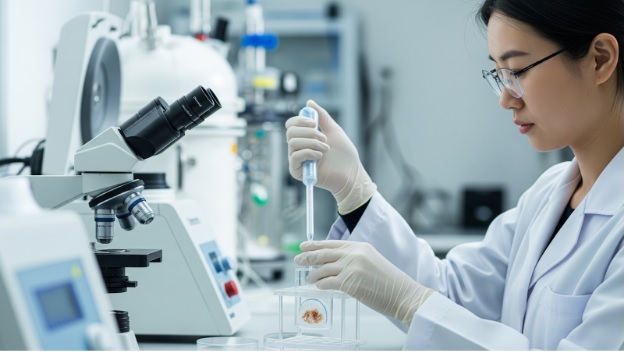Der-1 Recombinant Protein: Properties, Production, Storage, and Research Applications

Researchers can draw valid conclusions only when results are consistent throughout the study. Low yield and batch-to-batch variability of native proteins make it difficult to get reliable results. The recombinant protein technology addresses these challenges. It uses a host system, also known as an expression system, for large-scale production of proteins. These proteins are called recombinant proteins.
Der-1 recombinant protein is a good example of recombinant proteins produced in host systems such as E. coli.
What is Der-1 Recombinant Protein?
The human immune system recognizes Der-1 protein as a major allergen. It naturally comes from a common home dust mite called Dermatophagoides pteronyssinus. It plays a crucial role in the mite’s digestive system. However, in susceptible individuals, it can contribute to conditions such as allergic rhinitis, asthma, and atopic dermatitis.
Researchers require purified and consistent Der-1 recombinant proteins to investigate how the immune system responds to them. This helps in developing standardized assays and evaluating potential therapeutics.
Key features of Der-1 recombinant protein:
Stability
The recombinant Der-1 protein is stable and does not degrade during storage and experimentation.
Reproducibility
The composition and activity are consistent across multiple batches. Results are comparable across studies.
Native Der-1 Protein Properties
Recombinant Der-1 comes with all properties of the native protein. For example, it has the allergenic epitopes critical for immune recognition.
Production and Purification
High yield, purity, and reproducibility of recombinant Der-1 require advanced molecular biology and protein engineering techniques.
First, the DNA sequence encoding Der-1 is inserted into a suitable plasmid vector. The vector is then introduced into a bacterial expression system such as Escherichia coli. The expression system functions like a biological factory for the rapid and scalable production of the protein.
A short sequence of histidine residues (His-tag) is added at one end of the Der-1 protein. The protein mixture then undergoes chromatography, passing through a column containing metal ions. The His-tag added to the protein binds strongly with the metal ions, and the rest of the proteins are washed away. This process ensures that there are no contaminants that can interfere with experiments.
As compared to Der-1 proteins isolated from natural sources, Der-1 recombinant proteins offer the following advantages:
- Batch-to-batch consistency
- High yield
- Reduced risk of contamination
- Stability
Storage and Handling
The reliability of the experiment results depends on the stability, structural integrity, and biological activity of the protein. Therefore, proper storage and handling are essential.
Storage Conditions
Temperature
Depending on the formulation and buffer conditions, Der-1 recombinant protein should be stored at -20 °C or -80 °C for long-term storage. For short-term storage (a few days), it should be stored at 4°C.
Buffer Composition
From recombinant proteins to recombinant antibodies online, most biomolecules for research purposes come in stabilizing buffers containing salts, pH stabilizers, or glycerol. This buffer helps maintain folding and prevent aggregation.
| Important:Each freeze-thaw cycle can cause partial denaturation or aggregation of the protein. |
Handling
- Vigorous vortexing or any other kind of physical stress may cause denaturing. Therefore, the protein must be handled gently.
- Minimizing adsorption and contamination requires using sterile, low-binding tubes and pipette tips.
- Der-1 is a potent allergen. Work under recommended biosafety conditions.
- Use proper personal protective equipment (PPE) and containment practices.
Applications in Research and Medicine
Allergy Mechanism Studies
The recombinant protein mimics the properties of the native protein, enabling researchers to map immune pathways, identify allergenic epitopes, and understand diseases such as asthma, allergic rhinitis, and atopic dermatitis at the molecular level.
Diagnostics
Recombinant Der-1 delivers consistent and reliable results in skin prick tests, in vitro diagnostic kits, and serological assays.
Therapeutic Research
Researchers use recombinant Der-1 in the preclinical evaluation of allergy treatments. They use it to test immunotherapy approaches, including peptide-based vaccines, allergen-specific immunotherapy (AIT), and monoclonal antibodies designed to block allergen–IgE interactions.
Comparative Allergen Studies
Researchers compare Der-1 with Der p 2 or other allergens to study how dust mite allergens cross-react. This knowledge is crucial for the development of multi-allergen vaccines.







